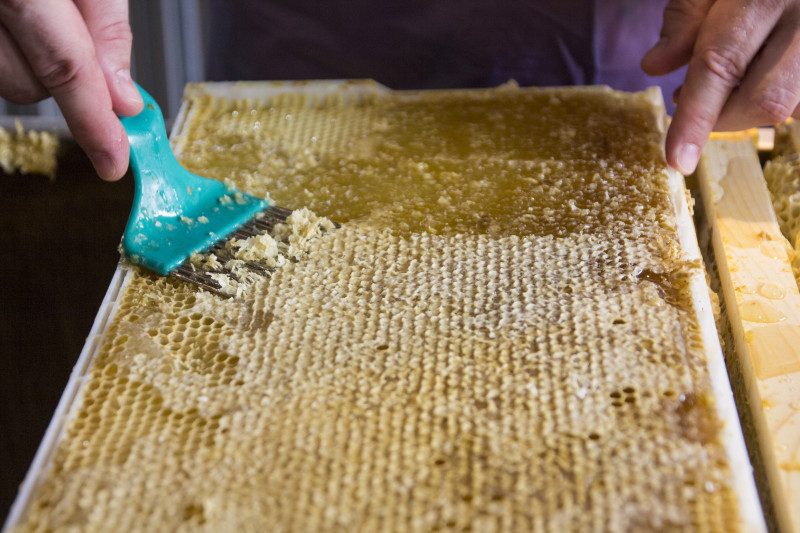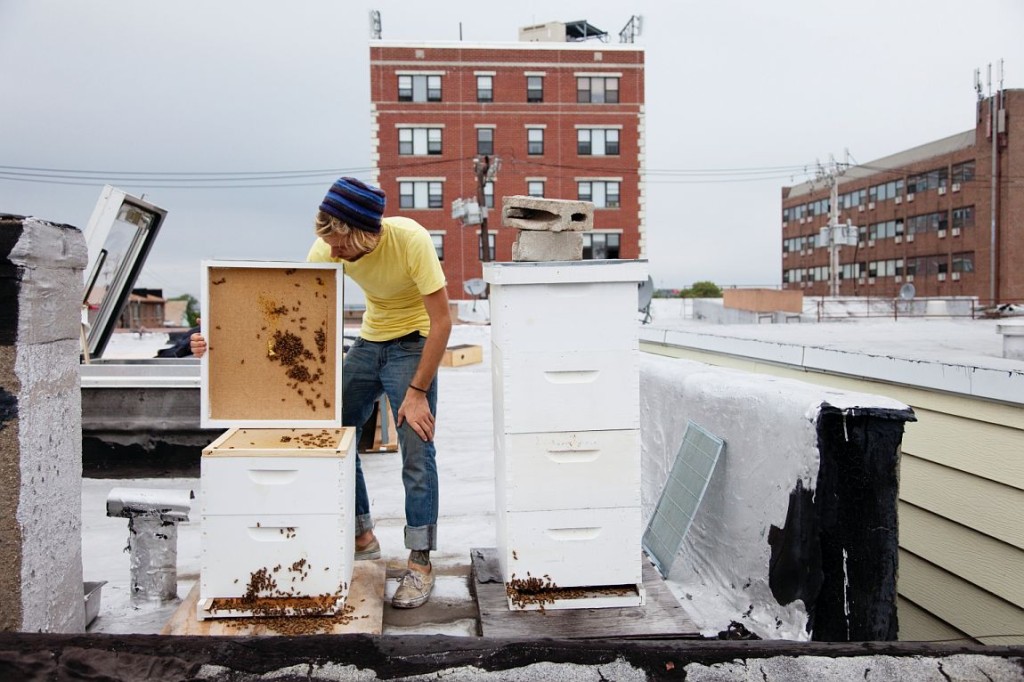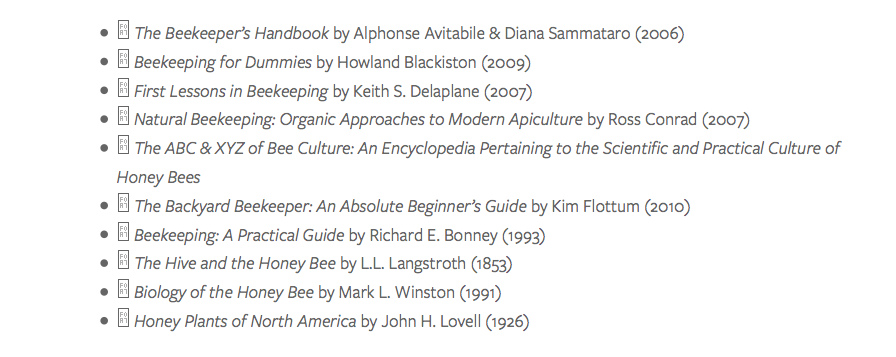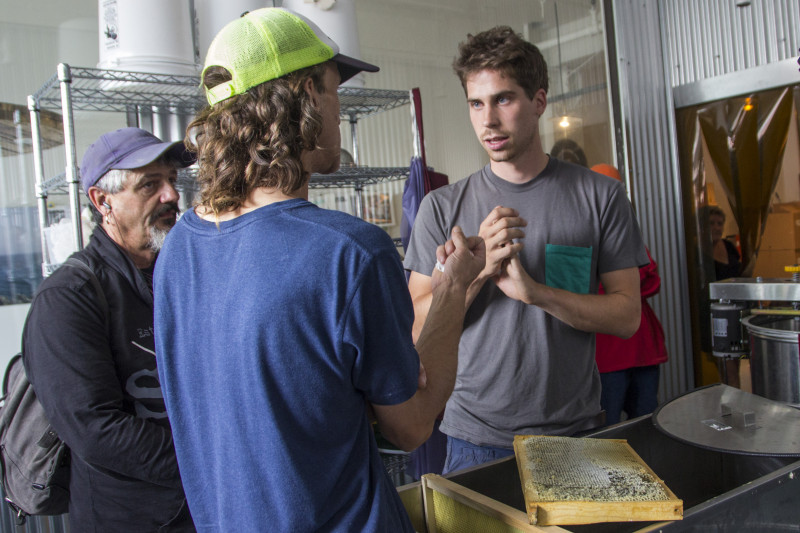Urban Beekeeping: High-Rising Bees
Since the late 1990s, urban beekeeping has been on the rise as bans have been overturned–the result of a yearning for local food and a “return to simpler, more agrarian times.” The other big reason is, of course, the disappearance of bees in great numbers due to pesticides, parasites and extreme weather, among other reasons. A growing trend that creates a positive, mutually beneficial relationship for bees and humans alike, urban beekeeping not only gives bees a safe habitat to flourish and pollinate, it also works to educate city dwellers about where their food is coming from.
This marks a drastic change from the first half of the 20th century, when urban beekeeping became illegal in most cities in North America, as “municipalities sought to distance themselves from their agricultural past.” City bans were also levied against Africanized “killer bees”, which allegedly chased people and stung them to death–the main reason why Los Angeles was so late on the urban beekeeping bandwagon, as Africanized bees are more commonplace there. (In 2014, Los Angeles finally granted urban beekeeping legal status in its residential areas. The truth is it was already being practiced–but in an underground fashion. Due to its warm and sunny climate, Los Angeles is the ideal city for urban beekeeping.) But on the subject of “killer bees”, most wild bees are perfectly fine – especially if bred with more domestic breeds, creating a hybrid bee. Strong reactions to bee stings are extremely rare, ranging from only 40 to 100 a year.

Next week, New York City will host its Honey Week. The Big Apple banned bees in 1999, considering them to be wild animals, but the ban was lifted in 2010 after years of petitioning by apiarists (beekeepers), and now New York is witnessing, in the words of one student, a “full blown social phenomenon.” According to Andrew Cote, founder of the New York City Beekeepers Association, “There has never been urban beekeeping in New York at this level. The exponential growth, it’s unparalleled.”
In Montreal, Alvéole is the foremost honey-centric business in the city, “buzzing with ideas for rallying citizens around bees” and merging beekeeping, education and the community, as told on their site. Launched in 2012, every September, the Alvéole team goes through the various neighborhoods in Montreal to collect honey. Each neighborhood provides a different kind of honey, with its own unique color–something that can’t be done in the world of mono-culture.

‘‘The goal is to see the difference and to create a link between the backyard and the honey produced in that neighborhood,’’ says Alexandre McLean, Alvéole cofounder and beekeeper.
Alvéole cofounders (McLean and friends Declan Rankin Jardin and Etienne Lapierre) spent five years in Manitoba working as beekeepers with McLean’s uncle, before realizing there was a void in the Montreal market. McLean says that before Alvéole, urban beekeeping in Montreal was a best-kept secret in institutions such as downtown UQÀM (Université du Québec à Montréal), which has rooftop hives.
As part of their role, urban beekeepers are becoming educators, too. Organizations and businesses are popping up all over North America, and most if not all offer classes and workshops for people to learn about urban beekeeping and why bees are fundamental to modern society. Alvéole does that and more, offering a full installation service that includes consultation, check-up and harvest, helping individuals and organizations navigate the difficulties of urban beekeeping safely. Some of their hives are on the rooftops of elementary and high schools, providing opportunities to teach children and teens about bees and beekeeping, helping the youth connect with nature, even amongst high-rises.
‘‘It will in turn help them make smarter choices,’’ says McLean, in being more conscious about the importance of bees in the food system, more mindful of nutrition and their overall attitude toward bees. It also educates them about local and urban agriculture in their area, which is important to keep it alive.

Cities are also working toward a safer space for bees–planting more trees and flowers, like with initiatives such as MillionTreesNYC. Many cities now have straightforward rules for those who wish to become beekeepers. For instance, Vancouver has a page on its official website explaining very simply what to do to become an urban beekeeper–for starters, reviewing their guidelines and registering your beehive. Most cities also have bee swarm help numbers, in case things don’t run as smoothly as expected.
For aspiring beekeepers, McLean suggests installing hives on rooftops to avoid interference with foot or vehicle traffic, and that it is important to have the right positioning: south east is usually ideal for bees. There can’t be too much wind, and hives should be easily accessible for the beekeepers. But most important, he says, when considering the occupation of urban beekeeper, is to get information and buy a few books beforehand. Like with any pet, there will be hardship and illness. ‘‘It’s a big commitment, but it’s rewarding,” McLean said.

As urban beekeeping becomes more prevalent in North America, beekeepers are branching out beyond the continent. Andrew Coté co-founded a charity with his beekeeper father Norman. Bees Without Borders helps villagers in poor areas of the world reap the profits of beekeeping. Alvéole also has projects abroad in Haiti, Mexico and Costa Rica. In the future ahead, there is hope that bees will continue buzzing for a long time to come.

